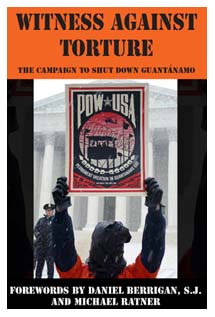Witness Against Torture: The Campaign to Shut Down Guantánamo

Shut it Down
Witness Against Torture:
The Campaign to Shut Down Guantánamo
Edited by Anna Brown, Matthew Daloisio, Michael Foley,
Patrick Stanley, and Matthew Vogel
Yellow Bike Press, 2008, 164 pages, $15–$25
As the history books are written, few words or places will symbolize the Bush years more than “torture” or Guantánamo. While much of the country has seemed to ignore―or at least remain quiet about―these horrors, not everyone has been silent.
Inspired by the nonviolent tradition of Dorothy Day and the Catholic Worker, a group of 25 activists calling themselves Witness Against Torture (WAT) embarked on an unprecedented 50-mile march in December 2005 to the prison camp at Guantánamo Bay in Cuba. Although they were unable to visit the inmates as they’d hoped, the group came closer than any civilians had and took a meaningful stand for human dignity.
Upon returning to the United States, WAT activists launched a creative campaign to bring the plight of those at Guantánamo directly to the halls of power. They organized major demonstrations and acts of civil disobedience in New York City and Washington, D.C., helping spark and then fuel a worldwide movement to shut down the nightmarish offshore penal colony and ban torture.
Witness Against Torture: A Campaign to Shut Down Guantánamo was clearly a labor of love, put together by these activists to chronicle this grassroots movement, educate the wider public about the issue, and inspire more people of conscience to take action. The book is chronologically ordered and contains a collection of personal reflections on the actions by participants, court statements by the protesters, press releases, photos, posters, flyers, and even an hour-long DVD that effectively transports the reader to the streets, courtrooms, and jail cells where the group’s witness has led them.
Throughout this concise volume are the heartbreaking stories and words of prisoners at Guantánamo, passionate pleas for justice by their lawyers, and excerpts from various fact-filled reports on the detainees that will undoubtedly be useful for anyone trying to articulate why the prison is an abomination.
One such excerpted study is a shocking but little-known February 2006 analysis by Seton Hall University Law School of the Department of Defense’s own data on the prisoners at Guantánamo that found that “only 5 percent of the detainees were captured by United States forces. Eighty-six percent of the detainees were arrested by either Pakistan or the Northern Alliance and turned over to United States custody … at a time in which the United States offered large bounties for capture of suspected enemies.”
 The final chapter is an invitation to join the group in its most ambitious action yet. WAT is maintaining a constant presence outside of the White House for the first 100 days of the new administration to hold President Obama to his pledge to close the prison and restore habeas corpus (see www.witnesstorture.org for more information).
The final chapter is an invitation to join the group in its most ambitious action yet. WAT is maintaining a constant presence outside of the White House for the first 100 days of the new administration to hold President Obama to his pledge to close the prison and restore habeas corpus (see www.witnesstorture.org for more information).
If Obama comes through, a new edition of this book will have to be written to celebrate the end of this horrific chapter in our history. But until the vast archipelago of secret and not-so-secret U.S. prisons are shut down and torture is explicitly banned, Witness Against Torture and those of us committed to justice will not be able to rest.
